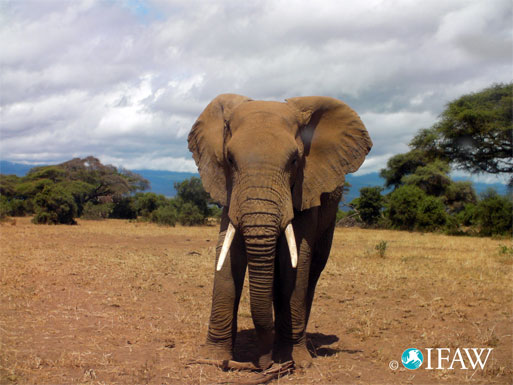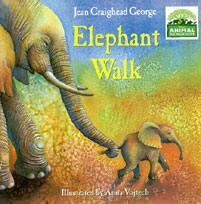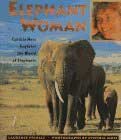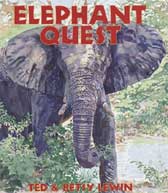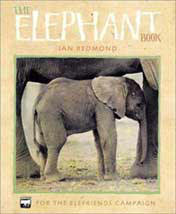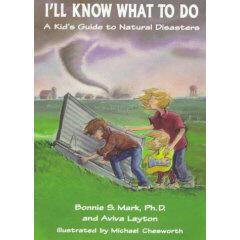 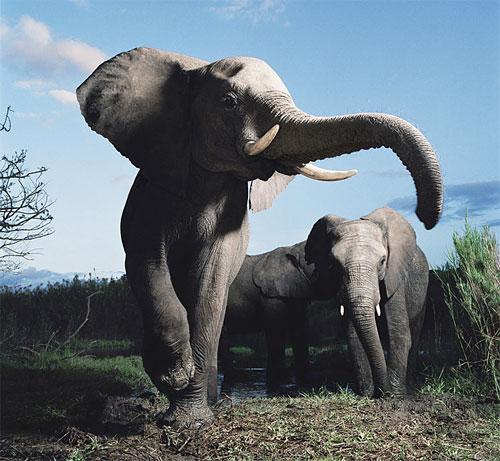
Elephants
Elephants are one of the most exciting and endearing of wild animals! Most people know that modern elephants fall into two sub-species: the African elephant (Loxodonta africana), and the Asian elephant (Elephas maximus). But few people can really explain the differences between the two -- other than continents of origin and perhaps ear size and shape. Here's the low down on the two basic types:
African Elephant (Loxodonta africana)
Habitat: The largest living land animal, the African elephant lives both on the grasslands (savannahs) and in the forests. African elephants in grasslands regions tend to live in larger groups than those who live in the forests. In fact, savannah elephants may join together in loosely knit clans of up to 70 members! But most often they can be found roaming about in a basic family unit of about 10 elephants. According to the WWF, important populations of African elephants occur in Tanzania, Botswana, and Zimbabwe, and probably in Congo, Gabon, and the Democratic Republic of Congo.
Asian Elephant (Elephas maximus)
Basic Facts About Elephants
Did you know...
Social
Structure
Elephant society is organized into two main groups: a male-centered bachelor group and a female-centered family herd. The female family herd is not exclusively female. Baby males and young teenage males also live in this group. But the group largely consists of adult females, their babies, their other female relatives (sisters, aunts, cousins) and their offspring. Because this group is held together by ties to or between the adult females, or mothers, this group is also called "matrifocal", or mother centered. The group is led by the most senior adult female, also known as the "matriarch". The matriarch has acquired decades of knowledge and experience that helps her lead the herd to the best feeding and watering sites during different seasons of the year and over vast distances. If there is not enough food and water to support the entire family herd it will break up into smaller groups that can forage separately. Matriarchs can use both scent gland secretions and infrasound (low frequency rumblings) to help them detect their sister bands even when many miles away.
All male elephants start out life as babies living with their mother in the matrifocal group. But as they mature they began straying from her more and more often and seeking out other young males. Young males enjoy play fighting and testing their strength against each other, an activity that prepares them for the real battles they will engage in as older bulls. By age thirteen or so these young males are ready to leave the protection and guidance of their mothers and aunties and begin their life in the bachelor herd. A bachelor herd is usually made up of four or five bulls, but there may be as many as thirty roaming together. Although the two groups may live very far apart, adult males know exactly when a female has entered into the rare and very brief stage during which she can can become pregnant (also known as "estrus"). Suddenly males appear as if out of nowhere, arriving right on time to mate with the receptive female.
Life
Cycle Like all mammals, an elephant starts it's life inside its mother's womb. Like most large mammals, the elephant takes a long time to develop, requiring a long pregnancy or "gestation". But elephant gestation takes much longer than any other mammal, on land or in the sea. In fact it takes an incredibly long 22 months to develop and grow before it is ready to be born. That's almost two years!
As noted above, in social structure, by the time a young male elephant hits puberty he will drift off to join a bachelor herd. However if the adolescent is a young female elephant, she will continue to live in her mother's herd, learning from the older females and helping to look after her younger siblings and cousins. By the time she is 12 to 14 years of age she will begin having her own babies. The young male elephant, meanwhile will not be ready to mate for another ten years. And in fact, because access to females in estrus is fiercely fought over by the more senior bull elephants, he may not get a chance to reproduce until he is 35 or 40 years old!
Threats
To Survival Poaching: Most people know that elephants have long been hunted for their ivory. In fact, in the 1970s half the elephant population of Africa disappeared ― ruthlessly slaughtered for their ivory tusks. But did you also know that in 1989, an international ban was imposed on the ivory trade? That means that while it is still legal to sell ivory within one's own country, it is illegal to export it to other countries (which is how the big money was made). Unfortunately, many tourists still purchase ivory trinkets and art objects while visiting African and Asian countries, and some people believe that it would be okay to allow some export of ivory, just to help out the economies of various African nations. Certainly we should not turn a deaf ear to the needs of our fellow humans, but is murdering such an exceptionally intelligent creature really the right solution? In addition to being threatened by the ivory trade, Asian elephants are also hunted for their hide and bone. In Thailand the hide is turned into shoes and hand bags. And in China the bone is is turned into bone ash and used in traditional medicines treating ulcers of the skin and stomach. Habitat loss: An even greater threat to elephants than poaching may be habitat loss. Nearly everywhere that elephants live, there are human beings looking to turn the elephants' wild feeding and breeding grounds into domestic farm and ranch land. An elephant is a very large animal. Grass and leaves are not very calorie rich foods. Therefore, an elephant herd requires a vast territory to range over in order to consume enough plant food without stripping their feeding area bare. As elephants are forced onto smaller and smaller range territories, there is greater and greater threat that the very trees, bushes, and grasslands that support the elephants will become so badly damaged that they will no longer be able to re-grow themselves and thus no longer be able to feed the elephants or all the other wild animals that feed there.
Even when the elephants are not being attacked however, this human disruption of the migration path is still doing harm. First of all, elephants are unable to access the vast feeding areas that they need (see Habitat Loss, above). And secondly, elephants may become cut off from other elephant groups or subgroups. As a result family ties, social interaction, and mating are then disrupted.
But unfortunately, many of the methods of capture used too often result in the death of the elephant. Thankfully programs are currently underway to encourage rural people to discontinue this risky methods, and to educate them successful methods of raising their own elephants. But providing information will not be enough. The fate of these wild elephants depends on the willingness of human beings to act with compassion and integrity.
Interesting Links About Elephants
The Elephant Book
To benefit the Elefriends Campaign
We can replant forests, and even reclaim deserts in time, but no one, when the last elephant has gone, can make another." Biologist Ian Redmond pays tribute to the pachyderm in The Elephant Book, with breathtaking photos of the African landscape. Divided into sections such as "The Architect of Africa," "Trunks and Tusks" and "Peaceful Coexistence," and peppered with quotes from the likes of David Attenborough and Jane Goodall, the book seeks to stop the ivory trade and eliminate poaching. Half the royalties go to the Elefriends Campaign, an elephant protection group based in London.
Elephant Games, Crafts, & Activities
|
CONNECTING KIDS with NATURE E.K. KIDS CLUB 
on this
Kids Can...
Giving Service
Taking a Stand Against
Taking A Spiritual
Empowering Children
MORE Fun &
Learning
|
|
Check out our great
Earth's
Kids
Kids
Can Change the World
action pages and Valentine's Day, Easter and Saint Patrick's Day pages for science and craft activities, reading and more!
Every
day is
EARTH
DAY!
Check
out our great fun
activities, art, & learning Wondering about the weather? Don't miss the Earth's Kids special feature on Climate Change & Global Warming!
Learn how to keep your
children safe in the event of a natural disaster. Tips to Teach Kids How to Wash Hands!
|
Copyright Earth's Kids 1999. All rights reserved.




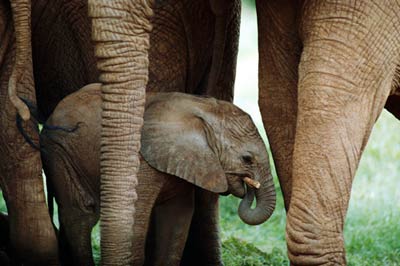

 The
male centered or "bachelor" herd is made up of adult males and
the older teenage males. Young males seem to follow a senior bull
male, a kind of patriarch whom they watch and learn from.
The
male centered or "bachelor" herd is made up of adult males and
the older teenage males. Young males seem to follow a senior bull
male, a kind of patriarch whom they watch and learn from.
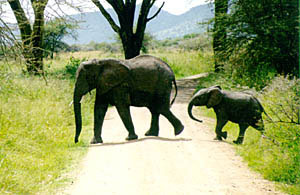 But
the mother elephant's work is still not done. She will spend the next
five years nursing her baby and protecting it from predators as it learns
the fundamentals of elephant life. And even once the baby is
weaned, it will continue to live with its mother and aunties. The
herd protects the still developing youngster and helps it find water
holes, mud wallows, and good grazing and foraging sites.
But
the mother elephant's work is still not done. She will spend the next
five years nursing her baby and protecting it from predators as it learns
the fundamentals of elephant life. And even once the baby is
weaned, it will continue to live with its mother and aunties. The
herd protects the still developing youngster and helps it find water
holes, mud wallows, and good grazing and foraging sites.
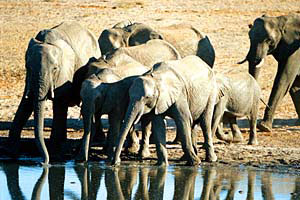 Habitat Fragmentation
-
Now
that human beings have encroached so heavily on elephant habitats,
it is not always possible for elephants to follow their normal
migration paths. When elephants try to ignore the crops, fences, and
other structures in their way, the local human residents get very
alarmed. Human attempts to drive elephants away sometimes leads
to elephants being injured, accidentally or deliberately. Similarly, the critical overlap
of human and elephant habitats means that sometimes it is the
elephants who accidentally harm the humans.
Habitat Fragmentation
-
Now
that human beings have encroached so heavily on elephant habitats,
it is not always possible for elephants to follow their normal
migration paths. When elephants try to ignore the crops, fences, and
other structures in their way, the local human residents get very
alarmed. Human attempts to drive elephants away sometimes leads
to elephants being injured, accidentally or deliberately. Similarly, the critical overlap
of human and elephant habitats means that sometimes it is the
elephants who accidentally harm the humans. High
Risk Capture Procedures
In Asia many people would rather capture a wild elephant and train it
than purchase one. Additionally, they find it much more attractive to
have a large, productive adult elephant
now, than to breed
elephants and wait ten years for the babies to grow up.
High
Risk Capture Procedures
In Asia many people would rather capture a wild elephant and train it
than purchase one. Additionally, they find it much more attractive to
have a large, productive adult elephant
now, than to breed
elephants and wait ten years for the babies to grow up. 